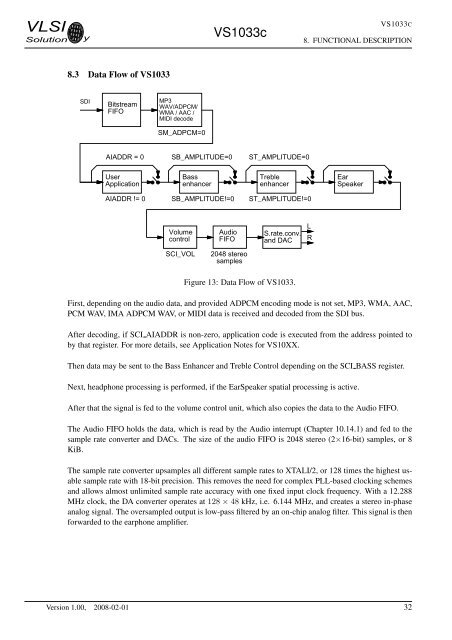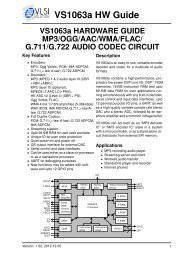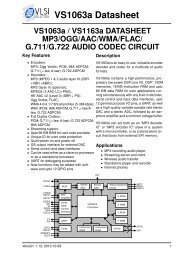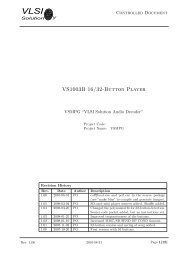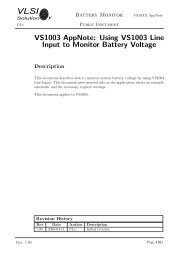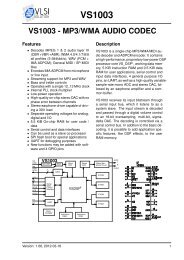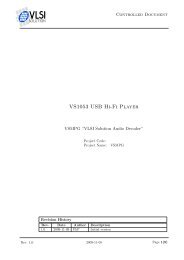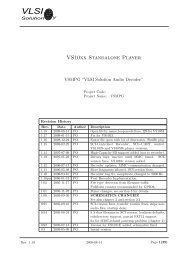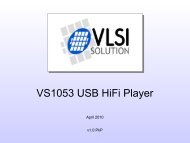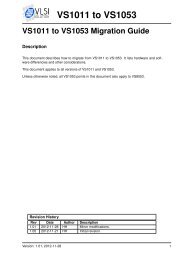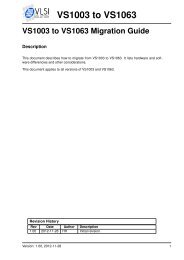VS1033 - MP3/AAC/WMA/MIDI AUDIO CODEC - VLSI Solution
VS1033 - MP3/AAC/WMA/MIDI AUDIO CODEC - VLSI Solution
VS1033 - MP3/AAC/WMA/MIDI AUDIO CODEC - VLSI Solution
Create successful ePaper yourself
Turn your PDF publications into a flip-book with our unique Google optimized e-Paper software.
<strong>VLSI</strong><strong>Solution</strong> y<strong>VS1033</strong>c<strong>VS1033</strong>C8. FUNCTIONAL DESCRIPTION8.3 Data Flow of <strong>VS1033</strong>SDIBitstreamFIFO<strong>MP3</strong>WAV/ADPCM/<strong>WMA</strong> / <strong>AAC</strong> /<strong>MIDI</strong> decodeSM_ADPCM=0AIADDR = 0SB_AMPLITUDE=0ST_AMPLITUDE=0UserApplicationBassenhancerTrebleenhancerEarSpeakerAIADDR != 0SB_AMPLITUDE!=0ST_AMPLITUDE!=0VolumecontrolAudioFIFOS.rate.conv.and DACLRSCI_VOL2048 stereosamplesFigure 13: Data Flow of <strong>VS1033</strong>.First, depending on the audio data, and provided ADPCM encoding mode is not set, <strong>MP3</strong>, <strong>WMA</strong>, <strong>AAC</strong>,PCM WAV, IMA ADPCM WAV, or <strong>MIDI</strong> data is received and decoded from the SDI bus.After decoding, if SCI AIADDR is non-zero, application code is executed from the address pointed toby that register. For more details, see Application Notes for VS10XX.Then data may be sent to the Bass Enhancer and Treble Control depending on the SCI BASS register.Next, headphone processing is performed, if the EarSpeaker spatial processing is active.After that the signal is fed to the volume control unit, which also copies the data to the Audio FIFO.The Audio FIFO holds the data, which is read by the Audio interrupt (Chapter 10.14.1) and fed to thesample rate converter and DACs. The size of the audio FIFO is 2048 stereo (2×16-bit) samples, or 8KiB.The sample rate converter upsamples all different sample rates to XTALI/2, or 128 times the highest usablesample rate with 18-bit precision. This removes the need for complex PLL-based clocking schemesand allows almost unlimited sample rate accuracy with one fixed input clock frequency. With a 12.288MHz clock, the DA converter operates at 128 × 48 kHz, i.e. 6.144 MHz, and creates a stereo in-phaseanalog signal. The oversampled output is low-pass filtered by an on-chip analog filter. This signal is thenforwarded to the earphone amplifier.Version 1.00, 2008-02-01 32


